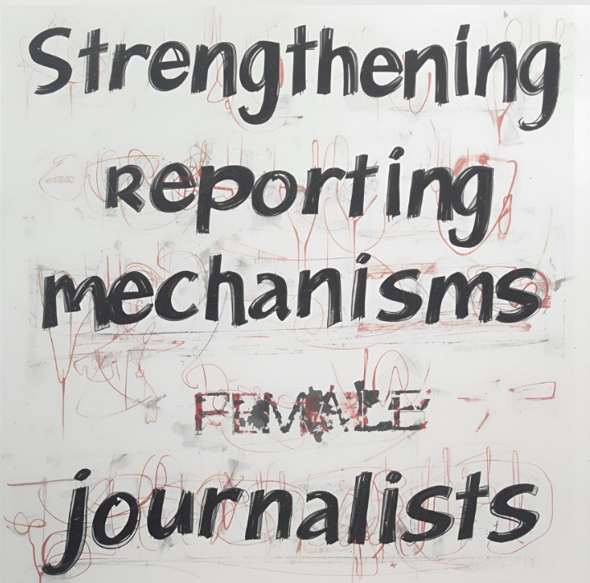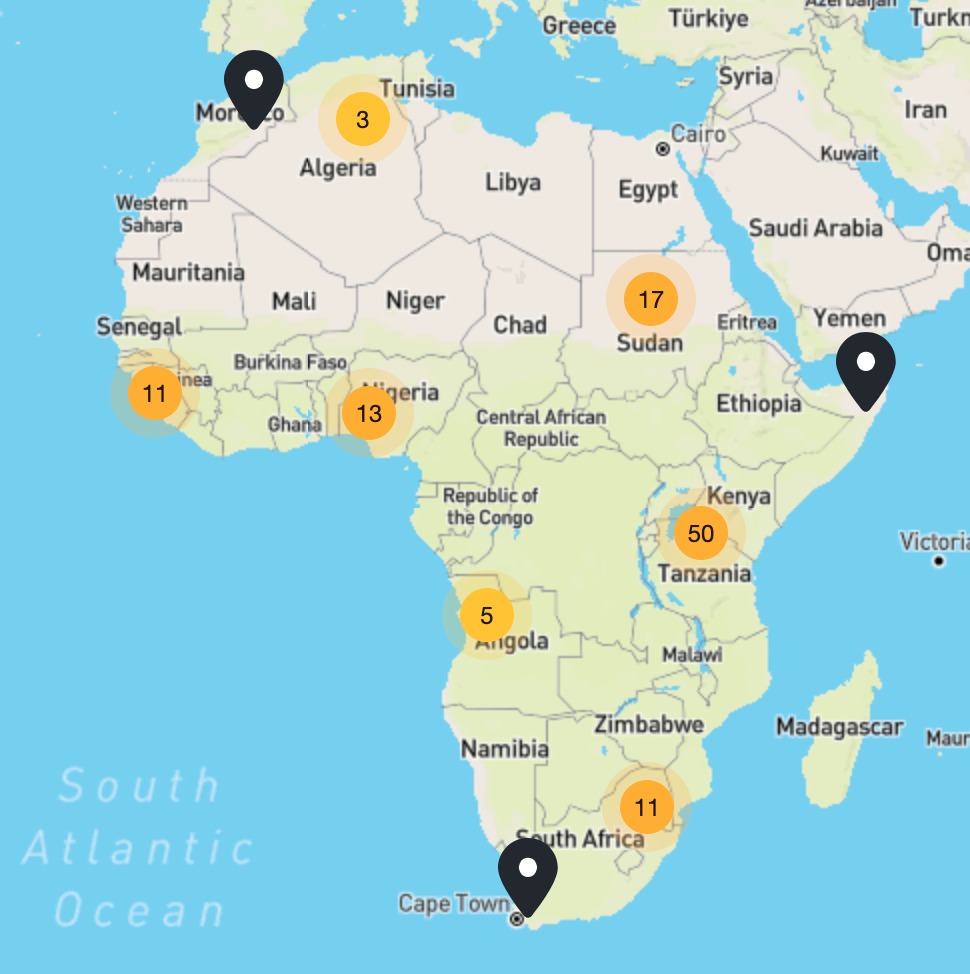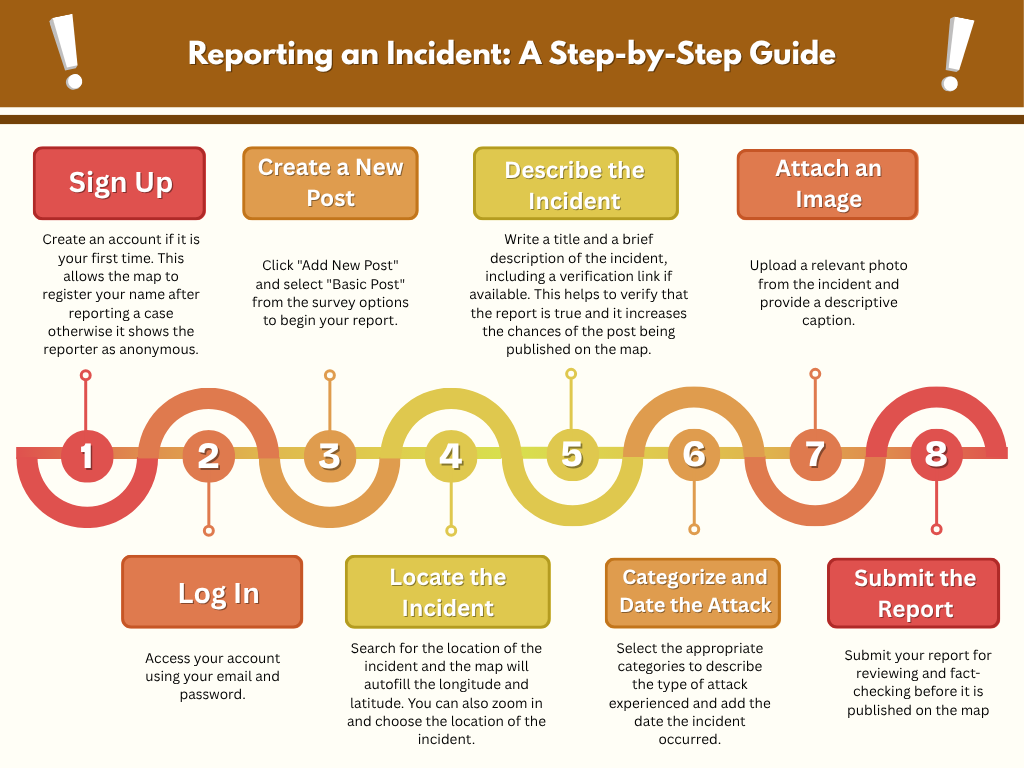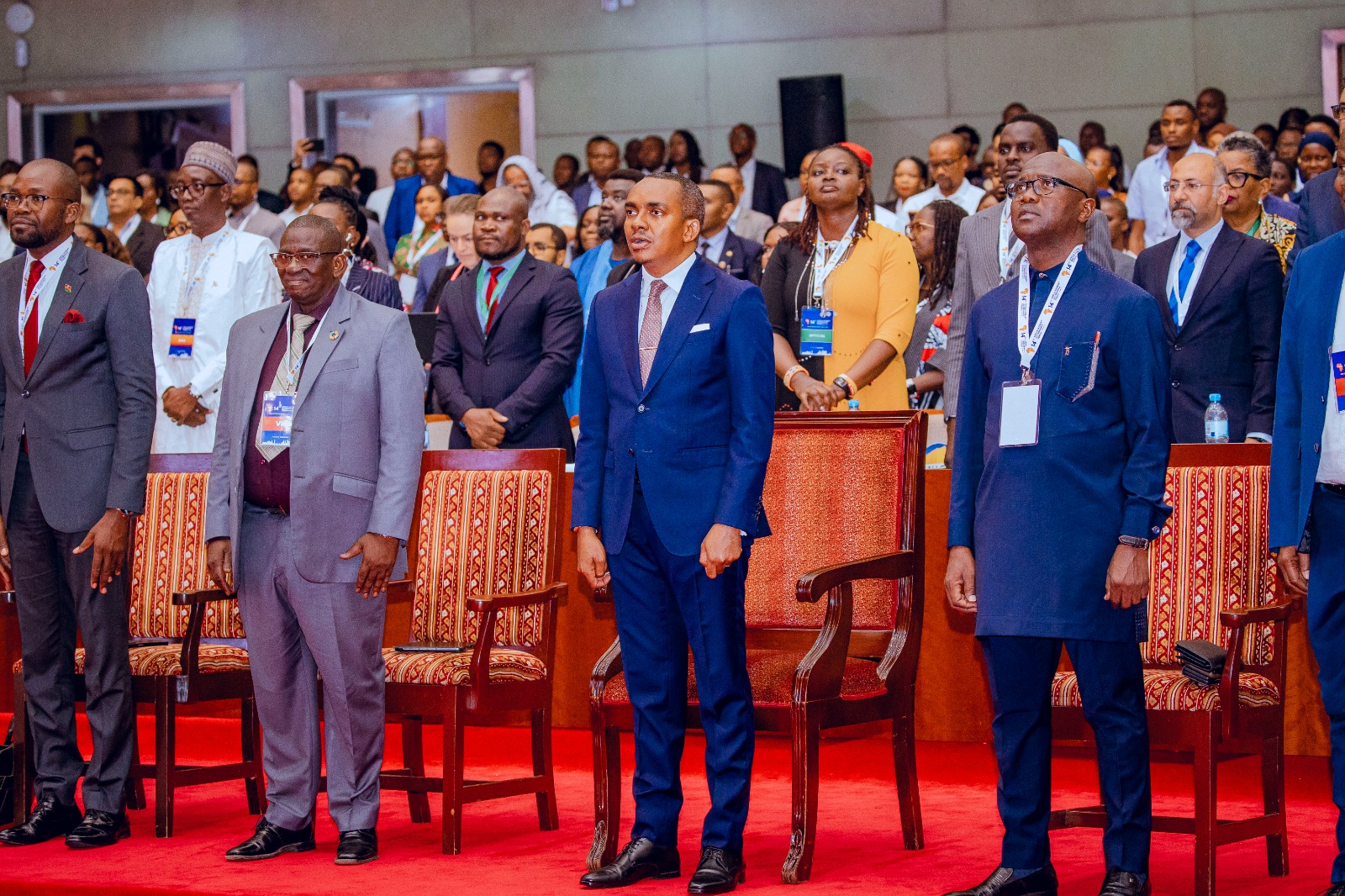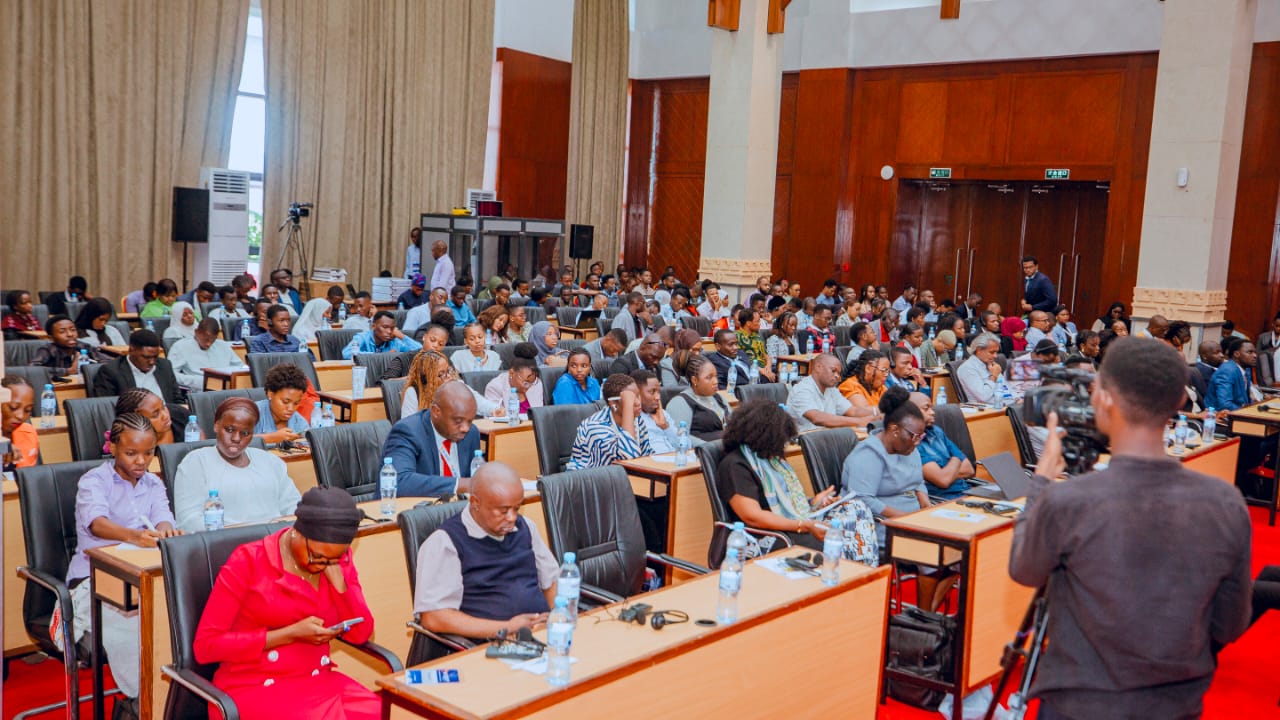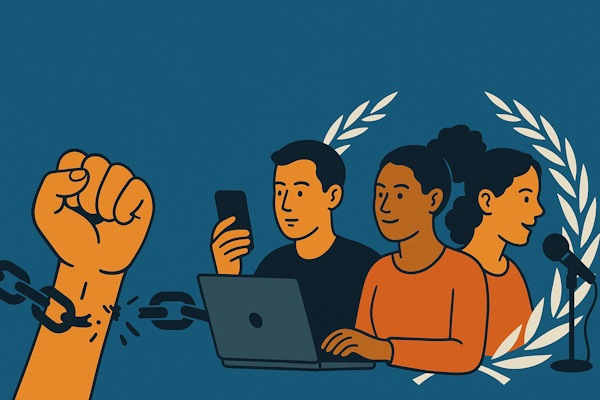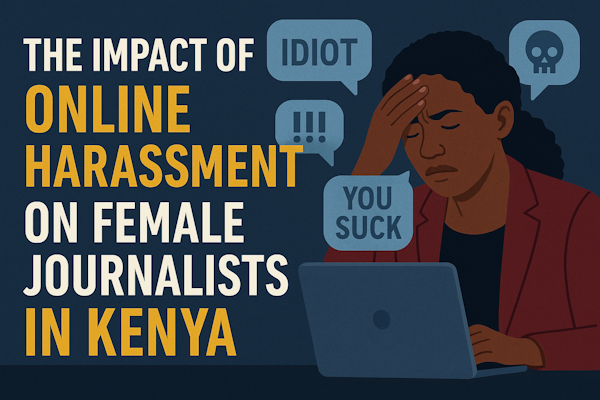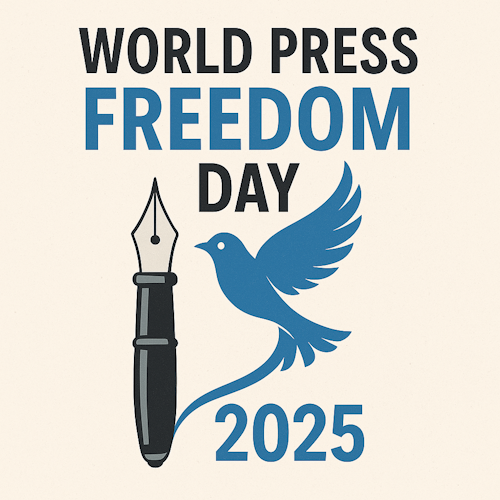By Raylenne Kambua The International Association of Women in Radio and Television (IAWRT) Kenya continues to lead efforts toward creating safer online and offline spaces for female journalists, a core mandate of our organization. Speaking during a recent training on monitoring and reporting violations against women journalists, Josephine Karani, IAWRT Kenya chapter head, stressed the importance of documenting such cases accurately. Evidence-building continues to be crucial as without data, we cannot meaningfully influence policy or push for systemic change that ensures women journalists’ safety. Gendered Risks in Journalism The session brought into sharp focus the gender-specific threats women face in journalism. Police commissioner Polycarp Ngufor from Cameroon underscored the hostile environment in which many operate. He explained that journalists in Cameroon are often targeted by state security forces, non-state actors, and criminal networks. But for women, these risks are magnified into gender-specific threats such as harassment, assault, and online abuse. “Female journalists in Cameroon, as well as across Africa, face a distinct set of gender threats that combine traditional risks to press freedom with gender-based violence in both physical and digital spaces,” he remarked. The Commissioner cited stark cases of female journalists’ harassments, including the 2022 assault on sports reporter Eyong Magdela Bissong, who was attacked by stadium officials and police, and the 2006 abduction of radio presenter Agnes Kalle Indwala. Testimonies further revealed cases where women reporting in crisis zones were threatened with sexual violence, or harassed by male sources demanding sexual favours in exchange for information. These cases, Commissioner Ngufor noted, reflect entrenched power imbalances and systemic impunity that silence women and weaken the media’s watchdog role. He further pointed out that the consequences of gender-based violence against journalists extend beyond the individual, silencing critical reporting on corruption, women’s rights, and minority issues, while instilling fear in others. Weak legal frameworks, stigma, underreporting, and lack of workplace protections continue to exacerbate the problem. The Commissioner emphasized the need for stronger policy actions, civil society engagement, and the implementation of international human rights standards such as the Maputo Protocol. Lessons from Iraq: Building Systems to Break Silence Dhea Subhee from UNESCO, drawing from Iraq’s experience, emphasized how entrenched impunity worsens journalist vulnerability. Between 2006 and 2020, Iraq lost more than 537 journalists to killings by militias, terrorists, and government forces. In response, UNESCO and partners established a national committee on the safety of journalists, which set up special investigation units, media courts, and a transformative digital reporting platform tailored for female journalists, such as the one developed by IAWRT. “We discovered that female journalists were in complete silence, never raising their voices to report violations. That is why we created a safe platform—so they no longer have to go to police stations, but can instead report directly to trusted bodies who will act on their behalf,” Dhea explained. In just four years, the platform received more than 5,000 reports, 68% of which involved online threats, blackmail, and sexualized disinformation campaigns. Drawing from Iraq’s model, it is evident that safe, trusted, and independent reporting mechanisms can break the culture of silence. In just four years, the platform received more than 5,000 reports, 68% of which involved online threats, blackmail, and sexualized disinformation campaigns. Drawing from Iraq’s model, it is evident that safe, trusted, and independent reporting mechanisms can break the culture of silence. The Call for Collaboration and Legal Action Other speakers emphasized collective solutions. Rachael Nakitare from IAWRT-kenya raised the painful reality of impunity in cases where journalists are attacked. “Who do we run to for protection?” She asked, highlighting the importance of tripartite agreements between law enforcement, legal practitioners, and media stakeholders. She explained how such frameworks ensure that cases are pursued with urgency and supported by pro bono legal aid when needed. From a legal perspective, William Oketch representing the Pan African Lawyers Union, emphasized the need for accessible legal aid, media defence funds, and regional guidelines. He explained that in countries like Kenya, lawyers are mandated to dedicate hours to free legal service, which could be directed toward defending journalists. He further called for open-access libraries on media law, threat-tracking systems, and regional advocacy mechanisms. “Journalism is the most sacred profession, and God , whoever the different religions design Him to be was the first Editorial Manager” . Mr. Oketch reflected. “I encourage all of us, let us not give up, and let us pull together in this partnership for the defence of journalism, and particularly our women journalists who face more harsher realities. We must defend it with all the tools available legal, institutional, and social.” Towards Safer Spaces for Women in Media When journalists, especially women, can report safely and have their cases acted upon, societies are better positioned to uphold press freedom and strengthen democracy. From the overview provided by the IAWRT Kenya chapter head, the journey towards enhancing press freedom and journalists safety continues through reporting and monitoring of violation cases. IAWRT’s observatory supported by UNESCO captures cases across all African countries, connecting media workers with legal and enforcement partners. The platform also provides for language localization, enabling users across the globe to interact with it seamlessly. IAWRT Kenya continues to stand at the forefront of this fight, ensuring that no woman journalist is left voiceless or unprotected. To report a violation, visit the secure reporting platform here: Report a Violation
Mapping Danger: New Tool To Protect Women Journalists in Africa
By Natalie Kakai What if doing your job puts your life at risk- just because you’re a woman speaking the truth? For many women journalists across Africa, this is the harsh reality. From online abuse to physical and sexual threats, the profession presents real danger. This is not just for what they report, but because of who they are. A tool that will change how the threats are documented and addressed is now here. “We are moving from mapping to action, “ declared Racheal Nakitare, project coordinator for the International Association of Women in Radio and Television (IAWRT) at the official launch of the second phase of the IAWRT led initiative to protect women journalists. SAFETY ON THE MAP In partnership with UNESCO’s international Programme for Development of Communication (IPDC), IAWRT launched a digital platform report.iawrt.or.ke to track and report attacks against women journalists across Africa. Developed with Kenya ICT Action Network (KICTANet) and powered by Ushahidi technology, the platform allows users to log incidents in real time, tag locations, and categorize threats, from harassment and censorship to physical and sexual violence. “This map is not just a tool. It’s a call to action, said Josephine Karani, Chairperson of IAWRT Kenya. Already over 120 stories have been documented from 16 countries, including Kenya, Uganda, Nigeria, Cameroon and Zambia. THE THREATS IN NUMBERS According to UNESCO’s Research on safety of women journalists: 73% have faced online violence 25% have been physically threatened 18% have been victims of sexual violence 20% of those attacked online have later been attacked offline. “Most female journalists in Africa don’t even speak about what they go through-because of fear, lack of legal support and isolation after speaking out”, Eunice Nankwanga, a journalist from Uganda said. The initiative is a regional force with focal points in each sub region. The participating countries are Kenya, Uganda, Tanzania, Ethiopia, South Sudan , Nigeria, Ghana, Sierra Leone, The Gambia, Zambia, Malawi, Botswana, Cameroon. The platform has regional leads for East Africa, Central Africa, West Africa, and Southern Africa. Phase one of the project focused on the training and documentation, while the recently launched phase two is on institutional engagement. IAWRT is now partnering with the Pan African Lawyers Union (PALU) and national enforcement agencies for evidence-based intervention. “Despite global efforts, journalism remains a dangerous profession. Women face disproportionate threats- not only for what they report, but simply because they are women.” Said Lea Simonini, Freedom of Expression and Safety of Journalists, UNESCO Regional Office. “Too often, these attacks are met with silence, impunity, inaction. We aim to create coordinated pathways for institutional response.” She added Law enforcement agencies across the continent have pledged support to the initiative. “The rights of female journalists are human rights,” said Commissioner Polycarp Ngufor of Cameroon. This project is at the heart of our work.” Kenya’s police representative Jared Ojuok, Zambia’s Jimmy Mhango, Nigeria’s Buhari Abdullahi and Uganda’s Beyanga Cornelius among other police representatives backed the project. ACTION The monitoring and reporting platform is open for use. If you are a journalist or know someone at risk, help map the truth. Report here: https://report.iawrt.or.ke/views/map For years, attacks on journalists both online and offline have largely gone unreported for fear of reprisal or simply not knowing where to report. During the International Day to End Impunity Against Journalists in 2022, IAWRT Kenya and Human Rights Journalists Network -Uganda launched an initiative to combat violence against women journalists. The project’s core component in partnership with UNESCO was the creation of a crowd sourcing digital map under the banner “Applying Modern Technologies To Enhance Mechanisms for Monitoring and Reporting Attacks against journalists in Africa”. The project has had a significant impact, successfully applying emerging digital innovations to promote the safety of journalists and combat impunity for crimes against them. The initiative has also enhanced the capacity of media monitors to use modern technologies, leading to increased awareness of crimes against journalists in Africa, particularly for women in the media. Going forward, the availability of real time data on attacks will empower duty bearers, such as law enforcement and legal institutions, strengthening their role in investigating and prosecuting perpetrators. The launch marks a pivotal moment in IAWRT’s mission to protect female journalists in Africa. By effectively mapping and documenting these cases, a robust body of data is built. This is not just a reporting tool but a powerful instrument for advocacy and change. IAWRT-Kenya is deeply committed to the protection of women journalists and are confident that sustained and collaborative action is the path to a safer environment for professionals across Africa and beyond.
My encounter with the Map
By Eva Wanja- IAWRT Kenya August 1, 2025 Standing Up for Women Journalists: A Powerful Step Forward in Digital Protection Today, I had the privilege of attending the virtual launch of a powerful tool that marks a critical turning point for women journalists across Africa. The Monitoring and Reporting Platform for Online Gender-Based Violence (OGBV) now officially live is more than just a digital system; it’s a lifeline. Hosted by the International Association of Women in Radio and Television- Kenya (IAWRT) in partnership with Pan African Lawyers Union (PALU) and Law enforcement agencies and supported by IPDC through UNESCO, the event brought together voices from across the continent, with over 45 delegates all united by one purpose: making journalism safer for women. What struck me the most was the urgency and raw honesty in the conversations. From doxxing and digital surveillance to physical assault and even killings, the threats women journalists face are relentless and deeply gendered. These aren’t just personal attacks; they’re part of a bigger strategy to silence truth-tellers and undermine press freedom. We were taken through how the platform works powered by AI and crowdsourced data with a live map showing real-time cases of harassment across countries. It was jarring to see so many dots on that map, each one a story of pain, fear, and sometimes silence. I couldn’t help but imagine the mental toll the self-censorship, the anxiety, the forced exits from the profession. One of the most impactful moments came from Jared Ojuok, speaking on behalf of law enforcement in Kenya. He reassured us of their commitment to protecting journalists, even emphasizing that violations perpetrated by the police would not be ignored. That kind of accountability, especially from security forces, is rare and necessary. The platform also does more than just document abuse. It connects victims to pro bono legal aid, engages law enforcement in training and sensitization, and builds evidence for policy advocacy. It’s a holistic response to a deep-rooted problem. This wasn’t just a launch. It felt like the beginning of a movement one that says: we see you, we hear you, and we are not backing down.
Opening Voices at the Africa Internet Governance Forum Encourage Revolutionizing Africa’s Digital Space
By Raylenne Kambua As the Africa Internet Governance Forum (AfIGF) commemorates 20 years of dialogue and impact since the World Summit on the Information Society (WSIS) 2005, the conversations this year were grounded in reflection and action. With more than 62% of the African population still offline, the call to build inclusive, resilient, and sovereign digital systems persists. In his opening keynote at the AIGF, Dr. Mactar Seck, Chief of Section for Emerging Frontiers Technologies, Innovation, and Digital Transformation at UNECA, set the tone: “Africa is the least connected continent in the world… Yet, we lead in mobile money transactions, accounting for 74% of global activity. This proves we have the potential and now we must channel it into digital resilience and innovation.” Dr. Mactar underscored the paradox that defines Africa’s digital journey. Despite being at the forefront of financial tech innovation, particularly mobile money, the continent still grapples with foundational issues such as low connectivity, underrepresentation of local languages online, and limited youth-focused digital capacity-building and support. His rallying call? Build resilient digital public infrastructure (DPIs) Remove trade barriers within the African Continental Free Trade Area (AfCFTA) Strengthen cybersecurity management Support private sector growth Continue engaging multi stakeholders in shaping Internet governance policies Equip Africa’s youth- who make up 42% of the world’s population with relevant digital competencies and support Dr. Mactar Seck- UNECA These priorities echoed in the remarks of Mr. Mohammed Hamis Abdula, Permanent Secretary at Tanzania’s Ministry of Communication and Information Technology. Framing the current era as a gateway between the 4th and 5th Industrial Revolutions, he reminded delegates that the speed of technological advancement through AI, robotics, IoT, drones, and big data, demands proactive governance. “We cannot ignore technologies considering their potential to transform all aspects of life. But transformation needs accommodative and impactful laws, policies,” he said. These priorities echoed in the remarks of Mr. Mohammed Hamis Abdula, Permanent Secretary at Tanzania’s Ministry of Communication and Information Technology. Framing the current era as a gateway between the 4th and 5th Industrial Revolutions, he reminded delegates that the speed of technological advancement through AI, robotics, IoT, drones, and big data, demands proactive governance. Tanzania, under President Samia Suluhu Hassan’s leadership, has made strategic moves towards a digital-first economy. The National Digital Economy Strategy and supporting legislative instruments ,including the National ICT Policy, the Cybercrimes Act, the Data Protection Act, and the E-Government Act , illustrate how governments can create enabling environments that safeguard innovation while promoting safe and inclusive tech ecosystems. Still, Mr. Abdula acknowledged that gender and digital disparities remain pressing concerns, calling on all stakeholders to collaborate in bridging the gaps that keep communities offline or underserved. Hon. Jerry William Silaha, Tanzania’s Minister for Communication and ICT, reinforced the fellow speakers sentiments and also celebrated the IGF’s 20-year milestone with a focus on future readiness. Hon. Jerry William Silaha, Tanzania’s Minister for Communication and ICT “We must reflect on our achievements and challenges and align our strategies with the Global Digital Compact.” Minister Silaha emphasized the importance of regional digital integration, citing Tanzania’s commitment to expanding mobile broadband infrastructure, now reaching up to 5G speeds for wide segments of the population. These investments are not only transforming connectivity in urban centers but are also empowering economies across neighboring countries. The AfIGF 2025 is a mirror reflecting both progress and the work that lies ahead. Across all sessions delegates were encouraged to shape Africa’s digital destiny with its people, languages, values, and innovation at the center.This means: Putting youth at the heart of digital transformation Creating digital literacy pipelines that don’t leave rural or marginalized populations behind Embedding inclusion in every policy, from cybersecurity to data governance Making Internet access not just a priority, but a right.
Digital Natives at the Centre of Africa’s Digital Future
By Raylenne Kambua On May 29, 2025, Dar es Salaam, Tanzania, became the epicenter of a powerful youth-led digital revolution. Held as a pre-event to the 14th Africa Internet Governance Forum (AfIGF), the Africa Youth Internet Governance Forum Youth Track brought together energetic and passionate young delegates from over 40 African countries. The goal? To equip Gen Z and other young Africans with the knowledge, tools, and inspiration to shape digital policies and assert their rightful place in internet governance dialogues. The central theme resounded clearly-Youth must be at the heart of internet governance. As digital natives, young people navigate and build the online world daily, yet their voices are often underrepresented in the policy spaces shaping that very ecosystem. Stakeholders, including Members of Parliament (MPs), emphasized that empowering youth in digital spaces is a collective responsibility, not solely that of governments but a shared duty among civil society, the private sector, and youth themselves. The day kicked off with a session on Digital Identity & Borderless Opportunity, a workshop designed to demystify digital identity systems and their connection to economic opportunities under the African Continental Free Trade Area (AfCFTA). Using real-life examples like Rwanda’s e-ID and Ghana’s mobile wallet interoperability, youth learned how secure digital IDs can unlock access to banking, healthcare, and even cross-border business. The session drove home a critical point: when youths understand their digital rights and identities, they gain power to transcend limitations and engage in Africa’s digital economy meaningfully. The African Youth brought to light pressing challenges faced in the digital space. The delegates from across the continent shared personal stories of losing access to their accounts without explanation, experiencing complete social media shutdowns during elections or protests, and facing repressive internet laws that stifled their ability to speak out or conduct online businesses. These experiences underscored a growing concern that content moderation, when applied without transparency or local context, often becomes a tool for silencing dissent and minority voices rather than protecting users. The sentiment that echoed clearly was that: “Content moderation must not become a tool to silence minority voices.” Participants emphasized the urgent need for youth-inclusive digital policies and accountability from both governments and tech platforms. They called for clearer guidelines, better appeals processes, and a rights-based approach to content governance that protects freedom of expression while upholding digital safety. Kenyan Senator- Catherine Muyeka addressing the youths during the AfYIGF session One of the most impactful moments of the day came during the session Youth and MPs – Intergenerational Dialogue on Digital Governance. In a rare show of unity, young people sat face-to-face with parliamentarians from across Africa to candidly discuss their digital realities. In her comment, Kenyan Senator Catherine Muyeka reminded the attendees of their duty in shaping internet policies and procedures, “While laws must follow due legislative processes, youth engagement is key to crafting inclusive digital frameworks,” she affirmed. MPs assured the young leaders that their concerns were heard and encouraged them to use formal channels to influence change. With the rapid digital transformation and the need to adopt digital identity systems in African countries, another important session explored how digital IDs, like Rwanda’s e-ID and Ghana’s mobile wallets can unlock cross-border opportunities under AfCFTA. While digital IDs promise access to services, trade, and mobility, challenges such as limited connectivity, lack of awareness, and exclusion from ID systems persist. Youth also voiced concerns about data privacy and the need for inclusive design. Despite these hurdles, the session emphasized that with the right support, digital IDs can be powerful tools for youth to thrive in Africa’s digital economy. The forum concluded with critical recommendations: Governments and stakeholders must invest in digital education Making tech and digital-focused courses free, accessible, and relevant. National digital strategies should reflect youth priorities, aspirations, amplify their innovations, and include them in decision-making processes. Most importantly, youth participation in governance must move beyond tokenism to genuine influence and co-creation As the Africa young IGF 2025 came to an end, the youth were reminded that they are responsible for the continent’s digital destiny. And they’re constantly prepared to lead, not merely take part, as the culture in similar Youth IGF engagements. The Youth Track of the AfIGF serves as a platform to empower young people to engage meaningfully in Internet governance. Through targeted workshops, interactive sessions, and mentorship, it builds the capacity of Africa’s emerging digital leaders by equipping them with the tools, insights, and connections necessary to shape a more inclusive, open, and forward-looking digital future. It is a space where youth voices actively contribute to the development of internet policy and technology across the continent.
Reclaiming Digital and Media Freedoms in the UPR Era
Reclaiming Digital and Media Freedoms in the UPR Era By Raylenne Kambua On the sidelines of KICTANet’s Africa Tech policy Summit array of events, IAWRT Kenya had the opportunity to participate in the Advocacy Engagement on Digital Rights in Kenya and the Universal Periodic Review (UPR) side event, on Tuesday , 13th May. This engagement aimed to enhance the capacity of various stakeholders and especially civil society organizations in the UPR process, which is a unique mechanism established in 2006 and that involves a review of the human rights records of all UN Member States, making Kenya a country of interest. While it is notable that strides have been made to promote human rights, most African countries are yet to fully achieve total freedom to even enjoy basic human rights both online and offline. With the growing dominance of technology, digital rights have become an integral part of human rights. Broadly defined, digital rights refer to the rights humans enjoy online through the use of electronic platforms and tools. By virtue of being human rights, they must be respected, protected, and upheld by all. Speaking at the meeting and referencing the SIFA 2024 report, Dr. Wakabi Wairagala, a researcher at CIPESA, highlighted a worrying trend -the decline of democratic governance across Africa and a corresponding rise in authoritarianism. According to the report, many African governments have increasingly employed repressive tools and tactics such as internet shutdowns, media censorship, surveillance, and regressive laws to stifle civic participation and democratic engagement. A recent example is the internet shutdown in Kenya during the June 2024 Finance Bill protests, which was widely seen as an attempt to silence dissenting voices. The report further categorizes the digital rights landscape across the continent, noting that most African countries only ‘Partially’ enjoy these rights. Kenya and Uganda fall within this category, while countries like Sudan, Egypt, Ethiopia, and Rwanda are classified as ‘Not Free.’ A Glimpse into press freedom in Kenya In Kenya, while media freedom is constitutionally guaranteed, its practical exercise faces numerous challenges. Speaking during this year’s World Press freedom Day, Kenya Editor’s Guild President, Zubeidah Kananu highlighted that ,despite the legal frameworks and right to press freedom, the country’s media landscape is marred by a growing culture of impunity, due to external pressures and government influence. On the other hand, in the online space, AMWIK’s 2024 report highlights that the rapid shift toward digital platforms has not spared female journalists from the growing threat of Technology-Facilitated Gender-Based Violence (TFGBV)—a major concern in the realm of digital rights. The report reveals that this persistent online abuse has contributed to a culture of self-censorship and the normalization of such violence. Notably, 40% of survey respondents believe that TFGBV is not treated as a criminal offense, further entrenching impunity and silencing of affected voices. In the most recent Universal Periodic Review (UPR) submissions, stakeholders raised serious concerns about threats, intimidation, harassment, surveillance, and physical assaults targeting journalists. These hostile conditions have led some journalists to self-censor their reporting out of fear of reprisals. Although there had been hope that previous recommendations on press freedom and the safety of journalists would be implemented, many remain unfulfilled. As a result, journalists continue to face deliberate attacks, both online and offline as seen during the 2024 Finance Bill Protests in Kenya. Why the continuous participation in the UPR Process matters for press freedom and digital rights in Kenya Key media stakeholders and CSOs participation in the URP holds the promise of liberating journalists from random online and offline brutality and holding the government accountable for their human rights commitments. This is a path toward real, systemic change. Key reasons why active participation in this process matters include to: Voice lived realities Seaking during the panel discussion, Joy Christine from Center for Human Rights and Policy Studies (CHRIPS) , sensitized on the need to document and gather data in this process.The UPR process allows civil society actors, including media stakeholders to submit “shadow reports” that reflect the actual experiences of journalists on the ground. IAWRT Kenya has been up to task in this kind of documentation, with their Monitoring and Reporting Violations Against Journalists in Africa mechanism. This form of data collection in the form of storytelling is powerful as it personalizes data and gives evidence-based statistics, turning them into human rights narratives. Build and strengthen solidarity The participation in the UPR brings Kenya’s press freedom challenges to the attention of other local stakeholders, donors, and international NGOs. A key objective of this meeting was to strengthen the broad-based coalition of civil society organisations, media, legal experts, and policymakers to advocate for the implementation of digital rights recommendations. Mitchelle Oyugi from Akina Mama Wa Afrika( AMWA), discouraged the silos mode of operation by CSO , and championed a unified approach for a strengthened voice and to bolster the advocacy efforts locally and even beyond. Safeguard journalists’ personal and professional lives Journalists continue to face threats ranging from physical attacks and arbitrary arrests to online harassment. Participation in the UPR provides a formal, international mechanism to document these violations, ensuring follow-up and in turn pressure governments to improve journalist safety. The participation of Kenya in the UPR process matters for press freedom and digital rights because it turns individual country struggles into public accountability. Previous contributions by stakeholders have provided journalists and media defenders not only with a global stage to speak truth to power, but also with the means to push for structural reforms. In Kenya, the relentless participation of media actors in the UPR process has already yielded tangible results. From regional and international condemnation of repression to local reforms in policy and practice. To protect press freedom and subsequent digital rights, media stakeholders must continue to seize this platform to their advantage.
Digital Danger: The Impact of Online Harassment on Female Journalists in Kenya
Digital Danger: The Impact of Online Harassment on Female Journalists in Kenya By Carolyne Gachacha Female journalists in Kenya continue to face significant challenges related to online harassment, which discourages many from fully embracing digital tools and platforms. A report by the International Association of Women in Radio and Television (IAWRT) reveals that online harassment has caused some women journalists to avoid using digital tools. Many female journalists have not joined professional associations that offer access to digital training, including in digital security. Additionally, the lack of reporting on technology-assisted gender-based violence—especially when it targets women journalists—further perpetuates the problem. The problem is worsened by several systemic issues: Few female journalists join professional associations that offer digital security training. Cases of technology-assisted gender violence often go unreported. Media houses and training institutions are slow to implement digital policies and update curricula to reflect emerging technologies. Regulatory gaps exist around AI, data privacy, cybersecurity, and social media governance. Technology platforms also play a role, with anonymity enabling abusers and algorithms amplifying harmful content. Despite growing efforts from advocacy groups, legal frameworks, and platform reforms, more needs to be done. Proposed solutions include: Strengthening support networks and advocacy. Holding tech platforms accountable. Improving digital literacy and safety training. Enacting and enforcing protective legislation. Fostering inclusive, supportive newsroom cultures. The document emphasizes that addressing online harassment is critical to enabling female journalists to safely and confidently engage with digital tools essential to modern journalism.
Is Artificial Intelligence (AI) The Future Of Free Expression?
Is Artificial Intelligence (AI) The Future Of Free Expression? By Nelly M. Nyangorora Opinion Every 3rd May, the world observes World Press Freedom Day. It is a reminder to industry players and the public of the importance of a free,independent and pluralistic press. The theme this year ,reflected on the urgency to adapt to the fast evolving technological space stressing the need for agility and upskilling for those in the media space. The Guardian in its publication of 3rd May titled “There is a war on journalists raging around the world: Let their voices be heard, reveals escalating threats faced by journalists. It points to a rising wave across the globe undermining press freedom that includes disinformation, state surveillance,media disruption and shutdown, imprisonment and even targeted violence. The report highlights a report of the Committee to Protect Journalists CPJ 2024, citing last year as the worst with at least 124 journalists killed. The report details increasing dangers journalists face around the globe, including widespread online misinformation. Some regimes are weaponizing digital tools to silence the press, while others are employing emerging technologies to protect journalists, enhance storytelling and expand the reach of factual reporting. It is a double edged sword!I had the privilege to engage with the esteemed members of the international association of women in radio and television IAWRT in a webinar, on Leveraging AI as Women Journalists. This session couldn’t have come at an opportune time, when women journalists are not just adapting to change but actively shaping it. We had a stimulating session that also incorporated digital safety awareness, and explored how AI is being woven into the fabric of journalism. With over 32 million internet users and a rapidly growing youth population that is tech savvy and media hungry, digital storytelling is evolving fast. The smartphone is the newsroom of choice as content remains King! Women journalists must keep pace and take advantage of AI to organise field notes, record, edit, write, distribute and monetize their content to remain relevant. IAWRTs research on the extent to which women journalists are using technology released early in the year,provided insights on how women journalists like those in purely online platforms like WIllow Health are already using technology integrating AI to automate tasks. AI offers immense tools like transcription software for interviews,generative AI to summarize lengthy reports or brainstorm catchy headlines. The presentation highlighted some international models like Schibsted, the Scandinavian media house that has automated more than 70 pc of its sports news using AI. This allows their journalists to focus on human driven narratives and investigative stories while AI handles the basics. Perhaps a great tool for women journalists struggling with work life balance owing to the demands of the digital news world. However, innovation must come with integrity. Ethical questions about AI in journalism are increasingly pressing. Who owns the content? How do we prevent algorithmic bias? What safeguards are needed? The media council of Kenya’s AI draft AI guidelines and the Kenya Bureau of Standards are in efforts to set national benchmarks. These are vital as they offer a framework to enable journalists in Kenya to embrace AI with accountability and transparency. Exciting opportunities on AI abound, there is the Kenya-UK Tech Hub AI challenge which seeks to support local innovations-including those designed by women to solve real world problems using AI. These are incubators of African led tech solutions with global relevance. The interactive session stirred curiosity as women journalists expressed eagerness to fully embrace AI tools calling for structured training programs,mentorship initiatives and partnerships with Ai developers. AI lightens the load of repetitive tasks allowing journalists to spend more time on investigative reporting, fact checking and community engagement. In a world drowning in information and misinformation,human judgement remains valuable. AI thus cannot replace humans, it only enhances the diversity in journalism. The future of journalism is not just adopting new tools but on who uses these tools, why they use them, and how they shape the stories we tell. Women journalists in Kenya are taking the challenge reporting in a brave new world in the face of AI, and unwaveringly pursuing truth, embodying the spirit of World Press Freedom Day. As we reflect on the escalating threats to journalism, let us amplify the voices of women leading the charge , support their journeys and ensure the future of journalism is one where freedom and innovation walk hand in hand. Nelly Moraa is an Independent Journalist and news entrepreneur managing integrityalliance.biz and a member of IAWRT. Her profile can be found on LinkedIn. https://www.linkedin.com/in/nelly-moraa-nyangorora-620359170?utm_source=share&utm_campaign=share_via&utm_content=profile&utm_medium=android_app
Empowering Journalism in the Age of AI
Empowering Journalism in the Age of AI By Everlyne Wanja This year’s World Press Freedom Day event, hosted by IAWRT-Kenya, focused on a timely and transformative theme – Reporting in the Brave New World – The Impact of AI on Press Freedom and the Media. One key highlight came from Nelly Moraa, who shared insights from their latest research report, noting that AI is already being broadly used in newsrooms, not to replace human labour, but to enhance it. ‘AI has not come about to replace human labour. It strengthens it.’ This message resonated strongly, especially in a room filled with women journalists who were encouraged to embrace AI as a tool for more impactful reporting.The conversation especially encouraged women journalists to explore how AI can improve their efficiency and storytelling and to engage with emerging tools that make the newsroom smarter, faster, and more inclusive. AI is making its mark in the media industry in several powerful ways: • Automated Transcription: Tools like Otter.ai or Descript help journalists transcribe interviews instantly, saving time and improving accuracy.• Fact-Checking: AI-powered platforms like Full Fact or ClaimReview help detect misinformation and verify claims in real time.• Data Analysis & Visualization: AI can sift through large datasets to uncover trends for example, analyzing election results, health data, or social media behaviour.• Content Summarization: AI tools can quickly summarize long documents, helping reporters digest information faster and produce clearer stories.• Translation: AI-powered translation tools help make journalism more accessible across languages and regions. The mood in the room was clear: journalists must not fear AI; they must shape how it is used. This means embracing innovation while remaining anchored in ethics, accuracy, and the human touch that defines good journalism. The discussion made it clear that while AI is a powerful tool, it still needs human judgment, ethical reflection, and editorial oversight. Journalists remain at the core of storytelling. AI just helps them do it better and faster. The takeaway? Don’t fear the future. Learn it, use it, and shape it.
Gains And Reversals Of The Beijing Platforms For Action; 30 Years And Counting
Gains And Reversals Of The Beijing Platforms For Action; 30 Years And Counting By Rachael Nakitare The 69th CSW held in New York from 10th to 21st March 2025, is the principal global intergovernmental body dedicated to promoting gender equality and the empowerment of women and girls. This year’s session was particularly significant as it took stoke of the milestones achieved and the challenges in the 30-year review and appraisal of the Beijing Platform for Action. Ms. Sima Bahous, Head of UN Women, cautioned that “misogyny is on the rise” at a time when females are bearing the brunt of multiple crises and conflict around the world. While there has been progress in advancing women’s rights, it is not fast nor far-reaching enough.” She said while emphasizing the need to include women in key decision making and peacebuilding roles. The International Association of Women in Radio and Television took particular attention to the section J of the Beijing Platform for Action; Section J1- increase the participation and access of women to expression and decision making in and through the media and new technologies of communication and Section J2- Promote a balanced and non-stereotypical portrayal of women in the media. Section J is critical for all the other areas of concern” (BPFA) because it provides the mirror for society to evaluate performance, “said Ms Sheila Katzaman, the President of IAWRT USA Chapter. IAWRT hosted a side event that evaluated the “Section J of BPFA; Gains and Reversals.” Technology and participation Social media platforms have opened up unprecedented space for women’s voices to be heard. Ms. Racheal Nakitare shared highlights from the report on the extend to which women in the media in Kenya have embraced technology”. file:///C:/Users/Admin/Downloads/Final-Report-For-Women-Journalists%20(2).pdf The study, which was collaborative effort between IAWRT Kenya and Association of Progressive Communications (APC), uses a gender lens in analysing how digital tools and platforms have empowered women journalists to profile themselves, boost their visibility overcome cultural barriers and stereotypes while navigating the predominantly male media landscape. In shedding light on the intersection of gender and technology, the findings contribute to the ongoing conversation about the representation of women across media platforms and how these perceptions affect / impact development It was however noted that the liberation of the online spaces has come with challenges which include increased technology facilitated violence against women, disinformation/ misinformation and fake news. “Women journalists are under attack in the on-line spaces throughout the world, impacting negatively on participatory rights of women and therefore ending up with news that lacks women’s perspectives. Geopolitical events require women voices’ said Professor Olga Jurasz, Professor of Law at Open University in the United Kingdom and Director, Centre for protecting Women online. Technology and especially social media platforms have become powerful avenues of advocacy and mobilization especially by citizen journalists. The Genz demonstrations witnessed in Kenya in June 2024 were basically coordinated virtually using the social media.” Said Ms. Nakitare urged Journalists to embrace technology and use it to enhance their professional work, thus amplify the voices of women across the world. Down memory lane Birgitte Jallov, Director, Empower House based in Denmark attended the women’s conference held in Beijing meeting 30 years ago and shared her experience of the role of media as envisaged in the women’s conferences held in Mexico City in 1975, Copenhagen in 1980, and Nairobi in 1985 where media was to catapulting all the other sectors of development. It was not until 1995 in Beijing that media was recognized as an entity in itself and so called for attention to women’s representation in and through the media “she said. Birgette has spent years setting up community radios across the world especially the global south and appreciates the importance and relevance of the radio as main source of information for the rural folk especially women and children. She stressed the need to have women own the radios especially with the new technologies that allow smaller portable radios including online podcasts. The power of radio to rural communities cannot be overemphasized.” She noted. The meeting also noted the complete lack of progression on section J 2 where women are still portrayed in their stereotypical roles. Hawa Taylor, Global advocate for Youth empowerment and, former employee of the United Nations Communications department observed that much as the Global Communication department of the United Nations is headed by a woman, women are generally lacking in decision making positions. “We must take responsibility and ensure women in the media especially those who appear on Television and other visual platforms are seen and appreciated for the value they bring to the table rather than their physical appearance” she lamented. More inclusion Despite the fact that a record 5845 members of civil society attended the CSW69, many more were locked out due to the complexities of the visa application and issuance processes. Radi Ali, Youth officer from Syria decried the “discrimination against LGBTQ and the gruelling immigration processes.” Its location at the United Nations Headquarters presented significant barriers to participants who had registered to attend the conference. APC created a feedback board dubbed “Access Denied” which attracted various reactions from the public. Some of the suggestions that came through the feedback board included relocating the CSW venue to United Nations offices in countries with easier access by all participating parties. While adding their voices to suggestions for revitalization of the CSW, some youths proposed discussions shifting onto the digital space. The Secretary General’s priority sessions for the next four years will include transferring caregiving systems, advancing gender equality, accelerating the implementation of agenda 2030 and strengthening women access to justice. This calls for deliberate and direct participation of women within the civil society, the engine that drives CSW forward. IAWRT-KE Team Rachael Nakitare Panelists IAWRT Panelists Nakitare presenting Plenary Plenary

